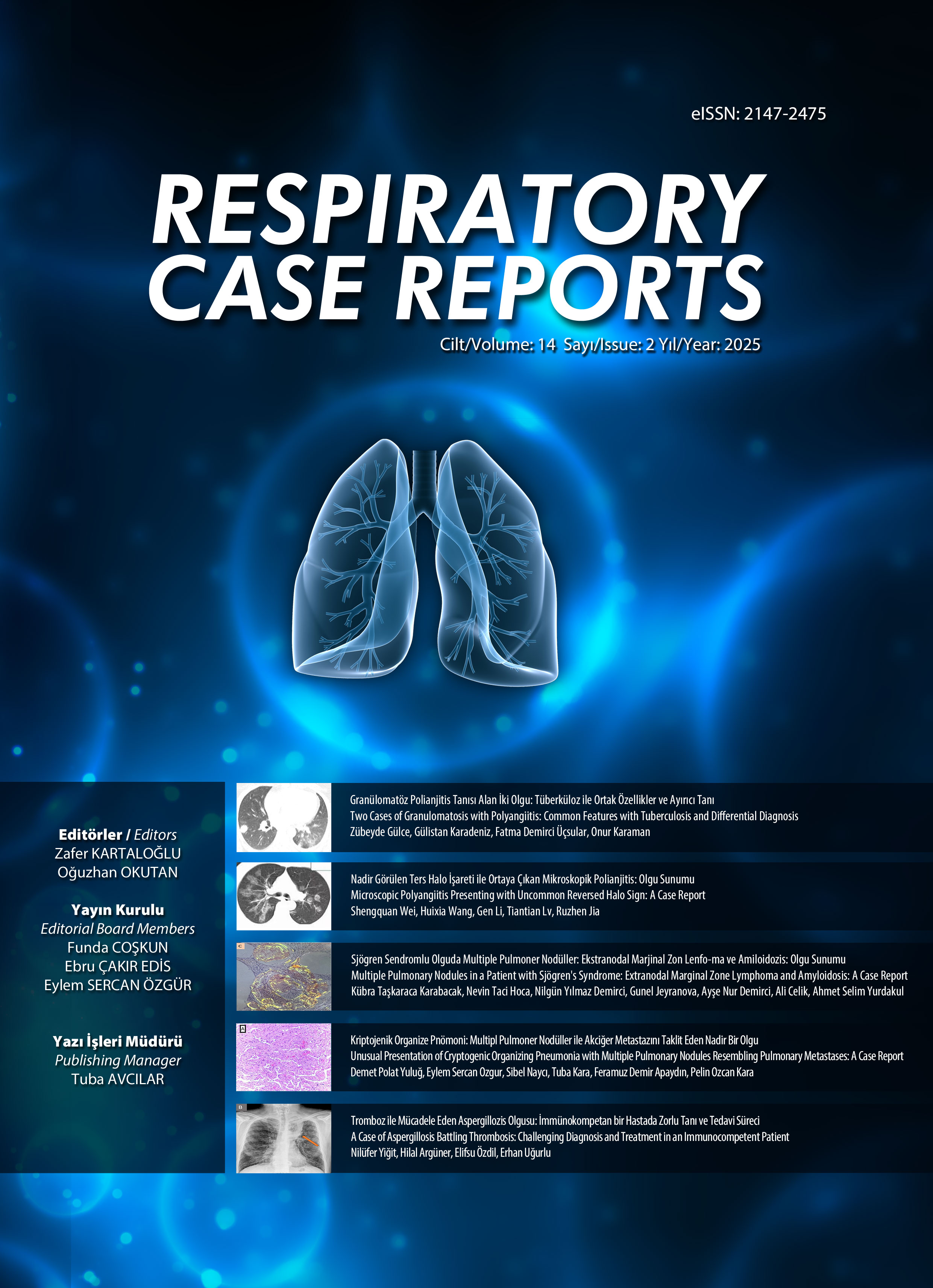e-ISSN 2147-2475

Volume: 4 Issue: 1 - February 2015
| CASE REPORT | |
| 1. | INTERACTIVE CASE REPORT: Pneumosiderosis in a Welder Masquerading as Hypersensitivity Pneumonitis Caused by Pigeons Ayşe Baççıoğlu, Füsun Kalpaklıoğlu, Önder Bozdoğan, Mikail İnal, Ömür Güngör doi: 10.5505/respircase.2015.63825 Pages 1 - 4 A 43-year-old man with a dyspnea, and cough had been a welder for 20 years, and had raised pigeons for 30 years. A pre-diagnosis of hypersensitivity pneumonitis was proposed with multiple micronodular opacities in radiology, exposure to pigeons, and hypoxemia. However, it was ruled out with continuing lung symptoms though avoidance of pigeons, no alveolitis in the bronchial lavage, corticosteroid insensitivity, and normal diffusion lung capacity. A diagnosis of welders lung disease was made with the occupational environment consisting of iron dust particles, compatible chest radiology, and positive staining for ferritin (Prussian blue stain) of the macrophages in the bronchial lavage. His hypoxemia was thought to improve after bronchial washing. He was recommended to quit his job and quit smoking, as well as feeding pigeons, since these factors potentially had an effect and predispose lung fibrosis, asthma, and cancer. |
| 2. | A Review of Dental Technicians Pneumoconiosis: Three Case Reports Fatma Ciftci, Aslıhan Gürün Kaya, Aydın Çiledağ, Akın Kaya doi: 10.5505/respircase.2015.40085 Pages 5 - 9 Dental technicians pneumoconiosis is a newly described, rare, and distinct type of pneumoconiosis. It is a result of direct exposure to dental alloy, acrylic resin, quartz, carbon, silica, and hard metal dust that are abundant in the air respired by dental technicians. We report herein three patients with respiratory complaints who were diagnosed with dental technicians pneumoconiosis. |
| 3. | Sulfasalazine-Induced Lung Disease: A Case Report Umut Sabri Kasapoğlu, İlim Irmak, Sibel Arınç, Pınar Atagün Güney, Fatma Armağan Hazar doi: 10.5505/respircase.2015.42104 Pages 10 - 12 The differential diagnosis of drug-induced lung disease is difficult. Due to non-specific clinical and histological findings and the presence of underlying disease, the diagnosis of drug induced pulmonary disease is difficult. A 33-year-old man with a diagnosis of rheumatoid arthritis who had been treated with sulfasalazine for three months was admitted due to coughing, dyspnea, and weight loss. There were no pathological findings in the physical examination. Non-homogeneous infiltrates in the bilateral upper lobes were seen on the thorax CT. With these clinical and radiological findings in the patient, sulfasalazine-induced lung disease was considered. After sulfasalazine treatment was terminated, the patient's clinical and radiological findings improved. Because sul-fasalazine-induced lung disease is rarely observed, we aimed to present this case with literature reviews. |
| 4. | A Case with a Considerably Delayed Diagnosis: Common Variable Immunodeficiency Fatma Tokgöz, Emine Aksoy, Yasemin Bodur, Tülin Sevim doi: 10.5505/respircase.2015.04695 Pages 13 - 18 Common variable immunodeficiency (CVID) is the most common clinically important primary immuno-deficiency that is characterized by frequent bacterial infections, autoimmune diseases, and increased incidence of malignancy. CVID can cause bronchiectasis, interstitial involvement, nodular formations, granulomatous disease, and interstitial pneumonia. A 31-year-old male patient who had a history of pernicious anemia, Hashimoto's thyroiditis, and gastric carcinoma diagnosed six years ago, was admitted to our clinic. He had undergone gastrectomy and was cured. In the first year of follow-up in the oncology clinic, lung nodules were detected and chemotherapy was administered. After chemotherapy, new nodules were accepted as metastasis and he was referred to a tertiary center for diagnosis. We hospitalized the case for further investigation. The tomographic imaging showed remarkable bronchiectasis accompanied by multiple nodules that were migrating compared to the previous images. Serum immunoglobulin levels decreased and he was diagnosed with CVID. The case, rarely seen and diagnosed quite late, is presented in the light of the literature. |
| 5. | INTERACTIVE CASE REPORT: Acute Sarcoidosis Case Presenting with Arthritis: Lofgren's Syndrome Gülistan Karadeniz, Özlem İnce, Dilek Gündüz, Zehra Yaşar, Melike Demir doi: 10.5505/respircase.2015.66588 Pages 19 - 23 Sarcoidosis is a multisystem disease that is characterized by non-caseating granulomatous reaction with unknown etiology. Lofgren's syndrome is an acute form of sarcoidosis, characterized by fever, arthralgia and/or arthritis, erythema nodosum, and bilateral hilar lymphadenopathy. Although lung symptoms are clinically dominant, there are an increasing number of cases with dominant rheumatologic symptoms. Herein, we reported a female patient who was diagnosed as Lofgren's syndrome presenting with bilateral ankle arthritis. |
| 6. | INTERACTIVE CASE REPORT: Pulmonary Alveolar Microlithiasis: A Case Report Tayfun Çalışkan, Oğuzhan Okutan, Ufuk Berber, Yasin Uyar, Ömer Ayten, Faruk Çiftçi, Zafer Kartaloğlu doi: 10.5505/respircase.2015.64326 Pages 24 - 28 Pulmonary alveolar microlithiasis (PAM) is a rare diffuse lung disease characterized by intra-alveolar accumulation of spherical calcium phosphate concretions (microliths). The disease predominates in a few countries, particularly Turkey, Italy, and Japan. Since most of the patients have no symptoms at the time of diagnosis, the disease is usually diagnosed incidentally during pulmonary radiography for other reasons, as in the current case. The SLC34A2 gene mutations can cause PAM. Characteristic radiographic findings of PAM consist of bilateral, fine, sand-like micronodules typically in the middle and lower zones. Although many authors argue that the typical radiological pattern precludes the requirement for a lung biopsy in most cases, it remains the most definitive procedure for confirmation of PAM. There is no known effective treatment for the disease. We present a case of pathologically diagnosed PAM with a review of the literature. |
| 7. | Malignant Pleural Mesothelioma at a Young Age İlknur Başyiğit, Haşim Boyacı, Esra Kuşlu Uçar, Kürşat Yıldız, Aslı Gül Akgül, Serap Argun Barış, Füsun Yıldız doi: 10.5505/respircase.2015.94695 Pages 29 - 33 Malignant mesothelioma is a tumor with poor prog-nosis that usually occurs 20-40 years after asbestos exposure. Here, we present a 27-year-old patient with malignant pleural mesothelioma who did not report any asbestos exposure. A female non-smoker was admitted with complaints of chest pain and dyspnea. The physical examination revealed dullness with percussion in the right lower lobe. There was a free-flowing pleural effusion through the right middle zone and bilaterally nodular opacities in chest x-ray. The ADA level, ARB and mycobacterium culture of the pleural fluid were negative. There were some malignant cells in the cytological examination of the fluid, and therefore the primary site of malignancy was evaluated. Thoracoscopy revealed nodular tumoral infiltration in the parietal pleura and thickness of the visceral layer. The pathological examination and immunostaining of the biopsy specimens were reported as biphasic malignant mesothelioma. In conclusion, mesothelioma should be considered in the case of malignant pleural effusion and detailed immunostaining should be performed in order to ascertain the diagnosis. |
| 8. | Endobronchial Metastasis from an Osteosarcoma Case Abdulsamet Sandal, Deniz Köksal, Funda Aksu, Emin Maden doi: 10.5505/respircase.2015.70299 Pages 34 - 37 Pulmonary metastases from extrathoracic malignan-cies are common and frequently seen as parenchy-mal nodules and pleural involvement. Endobronchial metastases are rare. We present a 34-year-old male who was diagnosed with right humerus osteosarcoma 10 months ago. Although the primary tumor had been controlled with surgical resection following preoperative chemotherapy and postoperative adjuvant chemotherapy, he had hemoptysis. He was admitted to another center two weeks ago with progressive dyspnea and episodes of hemoptysis within six weeks. Rigid bronchoscopy was performed for left lung atelectasis and tumor obstructing distal part of left main bronchus was removed. The pathological evaluation revealed osteosarcoma metastasis. In our clinic, we performed a thorax computerized tomography showing multiple metastases, the largest located in the apical segment of the lower left lobe. A tumoral lesion nearly obstructing the lower left lobe bronchus was seen during fiberoptic bronchoscopy. The tumor was inappropriate for endobronchial treatment and palliative external radiotherapy was planned. |
| 9. | INTERACTIVE CASE REPORT: Wegener's Granulomatosis Mimicking Pneumonia: Two Cases Ceyda Mahleç Anar, Erdem Yalçınkaya, Dursun Tatar, Pınar Çimen, Filiz Güldaval, İpek Ünsal, Özlem Edipoğlu, Derya Deniz, Hüseyin Halilçolar doi: 10.5505/respircase.2015.73644 Pages 38 - 43 Wegeners granulomatosis (WG) is a necrotizing granulomatous vasculitic disease that particularly involves the upper and lower respiratory tract and kidneys. A 68-year-old female patient was admitted to the hospital, a high erythrocyte sedimentation rate, fever, and progressive renal failure. Progression was observed in the patient's pulmonary infiltrations in spıte of wide- spectrum antibiotherapy. The renal biopsy revealed Wegeners granulomatosis. The second case, whose the first symptom was hearing loss, was a 31-year-old male patient who was admitted to the hospital with recurrent episodes of upper respiratory tract infection for two months and with symptoms of fever, and malaise for one week. The WG case with multiple organ involvement in which c-ANCA was determined positive and responded to treatment is discussed in this case presentation |
| 10. | INTERACTIVE CASE REPORT: Vasculitis Secondary to Chronic Obstructive Airway Disease Erhan Uğurlu, Neşe Dursunoğlu, Fatma Evyapan, Nagihan Yalçın doi: 10.5505/respircase.2015.52533 Pages 44 - 47 Anti-neutrophil cytoplasmic antibody (ANCA)-related vasculitis syndromes are a heterogeneous group of auto-immune vasculitic disorders that cause necrotizing inflammation in small vessels. Although the underlying causes are not clear, genetic and environmental factors are thought to play a major role. Meanwhile, chronic airway diseases are frequently reported to accompany vasculitic syndromes. Here we present a case with preexisting childhood asthma and bronchiectasis that developed microscopic poly-angiitis years after the onset of airway diseases that were assumed to be secondary to his preexisting airway conditions. |
| 11. | Traumatic Fat Embolism Syndrome: Two Cases Levent Özdemir, Burcu Özdemir, Suat Durkaya, Sema Nur Çalışkan, Ali Ersoy, Gökhan Büyükbayram, Zülal Özbolat, Kamil Dayan doi: 10.5505/respircase.2015.66375 Pages 48 - 52 Fat embolism syndrome is a rare condition that usually occurs as a complication of long bone trauma. It becomes apparent 24-72 hours after injury, with respiratory, neurological, urinary, ocular, and cutaneous symptoms and signs. Two male patients, 19 and 23 years old, with femur fractures, due to a traffic accident were evaluated for dyspnea, confusion, fever, petechial skin rash on the anterior thorax, and anterior axillary folds. Chest x-rays and cranial CT scans of the patients were normal; there was hypoxemia and hypocapnia in the measurement of the arterial blood gases. There were no pathologic findings to explain consciousness. The two patients, who had clinical diagnostic criteria, were given steroid prophylactic heparin, oxygen, and fluid therapy. Oxygenation and state of consciousness improved after treatment and the cases were operated on by orthopedics. |
| 12. | A Case of Agressive Fibromatosis in the Chest Wall Menduh Oruç, Fatih Meteroğlu, Ahmet Elbey, Atalay Şahin, Serdar Monis doi: 10.5505/respircase.2015.92005 Pages 53 - 55 Fibromatosis is also known as desmoid tumor and a rarely seen soft tissue tumor. Some reports categorize them as low grade fibrosarcoma, although they are histologically classified among benign soft tissue tumors. They are known to not metastasize but invade into the neighboring tissues. Therefore, their removal is essential. The etiology includes trauma, surgery, and hormonal disturbance, they are common in women. The diagnosis was made via mini thoracotomy in an 18-year-old woman with shortness of breath, dullness in the right chest, and trauma in her past. We completely removed the mass when the result yielded desmoid tumor. |
| 13. | Primary Benign Fibrous Histiocytoma of the Lung with FDG Involvement Mithat Fazlıoğlu, Tevfik İlker Akçam, Umut Özdamarlar, Nevin Fazlıoğlu doi: 10.5505/respircase.2015.17894 Pages 56 - 59 Fibrous histiocytoma is a benign tumoral lesion consisting of fibroblastic and histiocytic cells, accompanied by varying numbers of inflammatory cells, foamy histiocytes and siderophages, and has sheet- or short fascicle-type histomorphology. These tumors are generally localized in the dermis or the superficial subcutaneous tissue. Fibrous histiocytoma of the lung is an extremely rare tumor. This study presents a case that appeared as a nodular opacity in the posteroanterior (PA) lung graphy, which was then considered malignant after computerized tomography and PET-CT scans and operated on. The case was finally reported as primary benign fibrous histiocytoma of the lung after pathological examination. |
| 14. | Pulmonary Hydatid Disease Mimicking Lung Cancer Gülbanu Horzum Ekinci, Murat Kavas, Osman Hacıömeroğlu, Esra Akkütük Öngel, Ayşe Ersev, Adnan Yılmaz doi: 10.5505/respircase.2015.04909 Pages 60 - 63 Hydatid disease is endemic in Turkey. Although pulmonary hydatid disease may be diagnosed by clinical and radiological findings, atypical radiological presentation may lead to misdiagnosis or delays in diagnosis. A 22-year-old female was admitted with hemoptysis. Computed tomography of the thorax showed a mass lesion with central necrosis and atelectasis in the anterior segment of the right upper lobe. Bronchoscopy revealed a whitish-yellow gelatinous membrane in the anterior segment of the right upper lobe. Bronchial washing and forceps biopsy obtained diagnosis of hydatid diseases with cuticles. |
| 15. | Anomalies of Biceps Brachii Muscle as a Potantial Component of Poland's Syndrome Nurettin Yiyit, Hasan Saygın doi: 10.5505/respircase.2015.63634 Pages 64 - 66 Poland's syndrome is a rare congenital anomaly characterized by absence of the pectoral muscles, different chest deformities, and hand anomalies. Over time, many new features of the syndrome have been described. Although it has been reported that many muscles, in addition to the pectoral muscles, might have been affected in patients with Polands syndrome, the biceps brachii muscle has never been reported to be affected. The most accepted pathogenesis of Poland's syndrome is a temporary interruption of blood flow of the subclavian artery or its branches in the gestational period. The artery of the biceps brachii muscle is a branch of the subclavian artery. Herein, we present a patient with right-sided Polands syndrome and ipsilateral hypoplasia of the short head of the right biceps brachii muscle. We believe that the abnormalities of the biceps brachii muscle might be a component of Poland's syndrome. |
| 16. | INTERACTIVE CASE REPORT: A Successfully Treated Severe Case of Extensively Drug-Resistant Tuberculosis During Pregnancy Mehmet Ünlü, Pınar Çimen, Gülsüm Arı, Mustafa Şevket Dereli doi: 10.5505/respircase.2015.32932 Pages 67 - 71 The widespread emergence of extensively drug-resistant tuberculosis is an increasing global health care problem and affects young adults, including women of childbearing age. The treatment of extensively drug-resistant tuberculosis during pregnancy is still controversial and therapeutic abortions were previously recommended for pregnant patients. We describe herein a severe case of extensively drug-resistant tuberculosis that was successfully treated during pregnancy. The patient delivered a healthy baby and had no signs of relapse eight months after completing the treatment. In conclusion, extensively drug-resistant tuberculosis can be treated successfully during gestation and pregnant women should have the option to continue their pregnancy. |
| REVIEW ARTICLE | |
| 17. | Delays in the Diagnosis and Treatment of Pulmonary Tuberculosis Gülbanu Horzum Ekinci, Osman Hacıömeroğlu, Adnan Yılmaz doi: 10.5505/respircase.2015.25238 Pages 72 - 78 The primary goal of tuberculosis control programs is to minimize transmission within the community and reduce the incidence of tuberculosis by detecting and treating active tuberculosis cases as early as possible. Delays in the diagnosis and treatment of pulmonary tuberculosis can lead to a prolonged period of infection in the community. Delays are divided into patient delay, health care system delay, and total delay. The length of delays and possible reasons for delays in pulmonary tuberculosis patients are discussed in this paper. |











